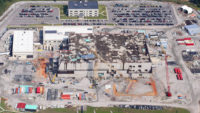The Dept. of Energy's $7.7-billion Mixed Oxide Fuel Fabrication Facility at the Savannah River Site in Aiken, S.C., isn't dead yet. But the Obama administration's March budget request to put the unfinished plutonium disposal facility into "cold standby" could sound the bedeviled project's death knell.

The lack of an official baseline cost and schedule estimate, lax oversight by the project owner and suspected unforeseen design challenges sent construction costs soaring, according to a recent report from the Government Accountability Office (GAO). Long-term operational costs have more than doubled over early estimates—to more than $500 million per year—and DOE has failed to line up a utility willing to use MOX fuel.
Despite Washington's move to halt the project—which swiftly was met with a lawsuit by the state of South Carolina against DOE—construction and design work continues.
The DOE's National Nuclear Security Administration (NNSA) originally commissioned the project in response to a 2000 agreement between the U.S. and Russia to dispose of 34 metric tons of surplus weapons-grade plutonium by converting it into mixed-oxide fuel, or MOX, for use in commercial nuclear reactors. Shaw Areva MOX Services—a joint venture led by the Shaw Group, now owned by CB&I—began construction in August 2007, with completion of the then-$4.8-billion project set for 2016. As recently as 2011, the contractor's project executive, Kelly Trice, told ENR the builder was looking to move up that completion date by 16 months. Shaw Areva has a contract to design, construct, test, operate and then demolish the facility.
But that acceleration didn't happen. Instead, the contractor's latest proposal, submitted to NNSA in 2012, added nearly $3 billion to the project's cost estimate and extended the completion date to 2019. A February 2014 GAO report suggested the cost escalation was a by-product of the NNSA's lack of an official baseline cost and schedule estimate for the project, which currently is publicly reported as being 60% complete.
GAO stated, "The contractor's September 2012 estimate did not fully reflect the characteristics of a high-quality estimate and cannot be considered reliable" and, moreover, did not qualify as an approved cost and schedule estimate.
"Managing projects that no longer have an approved cost and schedule estimate is a challenge because cost and schedule estimates provide a baseline for measuring progress,” the report continued. The GAO further noted that top DOE officials recently acknowledged “that not having such a baseline is the point of maximum risk of unrestricted cost growth on a project.”
Additionally, NNSA now estimates the contractor's original design was only roughly 58% complete—an estimate based upon the design costs incurred during construction, the report says.
Those costs have been considerable. According to GAO, NNSA's fiscal 2014 budget request "stated that the cost of critical-system components for the MOX facility averaged 60% higher than estimated."
The GAO report also noted that the contractor was experiencing difficulty "identifying suppliers and subcontractors able to fabricate and install equipment meeting nuclear quality assurance criteria." Another challenge has been greater-than-expected turnover of engineering and technical staff. As a result, says the report: "The project lost staff to other nuclear industry projects, including projects in neighboring states, [has resulted] in a nearly complete turnover of construction management personnel over a period of several years and the need to provide training to replacement personnel.
Whether cost increases are a result of inadequate estimating or significant owner-initiated design changes is unclear, since DOE has not issued any public report on MOX's construction—and since neither NNSA nor Shaw MOX Areva Services would respond to questions from ENR.
But Tom Clements, an adviser to the South Carolina chapter of the Sierra Club who has followed the project for nearly 15 years, believes one thing is clear. "They're having trouble getting the French design [to meet] U.S. standards," he says. "I think they've just had a huge headache designing the plant properly."




